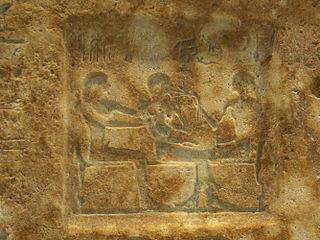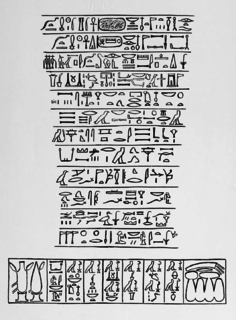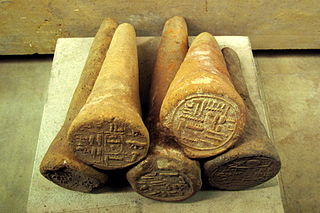
Amenhotep I from Ancient Egyptian "jmn-ḥtp" or "yamānuḥātap" meaning "Amun is satisfied" or Amenophis I, (,), from Ancient Greek Ἀμένωφις, additionally King Zeserkere, was the second Pharaoh of the 18th dynasty of Egypt. His reign is generally dated from 1526 to 1506 BC. He was a son of Ahmose I and Ahmose-Nefertari, but had at least two elder brothers, Ahmose-ankh and Ahmose Sapair, and was not expected to inherit the throne. However, sometime in the eight years between Ahmose I's 17th regnal year and his death, his heir apparent died and Amenhotep became crown prince. He then acceded to the throne and ruled for about 21 years. Although his reign is poorly documented, it is possible to piece together a basic history from available evidence. He inherited the kingdom formed by his father's military conquests and maintained dominance over Nubia and the Nile Delta but probably did not attempt to maintain Egyptian power in the Levant. He continued the rebuilding of temples in Upper Egypt and revolutionized mortuary complex design by separating his tomb from his mortuary temple, setting a trend in royal funerary monuments which would persist throughout the New Kingdom. After his death, he was deified as a patron god of Deir el-Medina.
Peter FitzGerald Dorman is an epigrapher, philologist, and Egyptologist. Recently a professor of history and archaeology at the American University of Beirut (AUB), he served as the 15th President of the university from 2008 to 2015. He spent most of his career as a professor and chair in the department of Near Eastern Languages and Civilizations (NELC) of the University of Chicago, and was director of Chicago House in Luxor, the Epigraphic Survey field project of the Oriental Institute. He is presently a professor emeritus of the University of Chicago.

God's Wife of Amun was the highest-ranking priestess of the Amun cult, an important religious institution in ancient Egypt. The cult was centered in Thebes in Upper Egypt during the Twenty-fifth and Twenty-sixth dynasties. The office had political importance as well as religious, since the two were closely related in ancient Egypt.
The Autobiography of Ahmose Pen Nekhbet is a tomb inscription from Ancient Egypt which is significant to Egyptology studies. Ahmose Pen Nekhbet was an ancient Egyptian official who started his career under Ahmose I and served all the pharaohs until Thutmose III. His autobiographical inscriptions are important for the understanding of the history of the early New Kingdom, though less detailed than those of his contemporary Ahmose, son of Ebana. In his tomb he mentions his brother Khaemwaset and his wife Ipu, who may be identical with the royal nurse Ipu, mother of Queen Satiah.
Sennefer or Senneferi was an ancient Egyptian official during the 18th Dynasty.

Ramose was the father and Hatnofer the mother of Senenmut, one of the most important state officials under the reign of the Egyptian queen Hatshepsut in the 18th dynasty of Egypt's New Kingdom. The commoner origins of Ramose and the rise of his son Senenmut were long considered to be prime examples of high social mobility in New Kingdom Egypt. For instance, almost nothing is known of Ramose's origins, but he seems to have been a man of modest means—anything from a tenant peasant or farmer, to an artisan or even a small landowner. When Ramose died he was a man aged 50–60. Hatnofer was an elderly lady, with grey or even white hair. They are believed to have been born at Armant, a town only ten miles (16 km) south of Thebes within Upper Egypt presumably during the reign of Ahmose I, the founder of Egypt's illustrious 18th dynasty.
Bas-relief carvings in the Ancient Egyptian temple of Deir el-Bahari depict events in the life of the pharaoh or monarch Hatshepsut of the Eighteenth Dynasty. They show the Egyptian gods, in particular Amun, presiding over her creation, and describe the ceremonies of her coronation. Their purpose was to confirm the legitimacy of her status as a woman pharaoh. Later rulers attempted to erase the inscriptions.
Tay was a high official of Ancient Egypt with the main title treasurer. He was in office under Hatshepsut and in the first years of Thutmose III. Tay is only known from three attestations. He appears in a rock inscription on the island of Sehel, in a letter that is dated by context under Hatshepsut and from a stela found on Sinai. The latter inscription is dated to year 25 under king Thutmose III. Tay is shown here standing behind the king. According to the rock inscription on Sehel he was on a military campaign with the queen to Nubia. The inscription also provides the throne name Maatkare, of queen Hatshepsut The exact date of the military enterprise is not known for sure, but may have happened in year 12 of the queen. Tay was therefore in office from about year 12 of Hatshepsut till about year 25 under Thutmose III. Under Hatshepsut there is also attested the treasurer Nehsi. Recently it has been suggested, that the office of the royal treasurer was divided into a northern and into a southern office. According to that, Nehesi was the northern treasurer under Hatshepsut, Tay the southern treasurer.
Seni was an Ancient Egyptian official with the titles king's son of Kush, overseer of the southern countries and mayor of the southern city (Thebes). He was in office under the kings Thutmosis I and Thutmosis II. As king's son of Kush he was the main official in charge of the Nubian provinces.

The high steward was an important official at the royal court in Ancient Egypt in the Middle Kingdom and in the New Kingdom. He was the main person in charge of the estates supplying the palace and the royal residence with food. The office appears in the 11th Dynasty. To the earliest title holders belong Henenu and Meketre. After the vizier and the treasurer this was the most important office at the royal court; important title holders of the 12th Dynasty were Siese and Khnumhotep III, both were later in their career appointed vizier.
Wadjetrenput was an Ancient Egyptian official with the title of a high steward. He was in office under the ruling queen Hatshepsut. Wadjetrenput is known from several inscriptions, but none of them is dated, making it hard to provide an exact chronological position for the high official within the reign of the queen. He appears on an ostracon found at Deir el-Bahari also naming the official Senenmut. The latter is well known from the reign of the queen, providing evidence that he also lived in her times. He appears in a rock inscription in southern Egypt, near Aswan. The inscription mentions Hatshepsut and king Thutmoses III providing evidence that the queen sent him on mission to quarry stones. On so called name stones he also appears with the title overseer of works in the Amun temple
Penre was an Ancient Egyptian official of the New Kingdom, in office under the ruling queen Hatshepsut. Penre was viceroy of Kush. The writing of his name varies on the monuments between Penre (Panre), Pare and Payre. Because of his high titles, he was one of the most important officials at the royal court, ruling the Nubian provinces. Kush is the Ancient Egyptian name for Nubia. Penre was little know till his tomb at Thebes was recently excavated by a Hungarian mission. On the canopic jars found in the tomb bears the titles first king's son and overseer of the southern foreign countries. Otherwise he is also known from several statue fragments. His father was called Sekheru, who also bore the title king's son. Penre was in office between the reigning year 2 of Hatshepsut, when a certain Seni was still in office, and year 18, when Inebny/Amenemnekhu is attested in that office. None of his monuments are dated, but one of his statues found in Nubia, must have been installed before the sole reign of Thutsmosis III. His burial is a shaft tomb, little survive from the tomb chapel, that was made of mud brick. The shaft was more than 11 meters deep. In the burial chamber at the bottom of the shaft were found the human remains of three adults and two children. Several objects of the burial equipment survived. They report the names Sennefer, Siamun and Penre. The fragments of the four canopic jars were still bearing Penre's name and titles. Items in the tomb include specifically prepared funerary items, objects of daily life, professional equipment and containers of provisions.

Inebny, also called Amenemnekhu was an Ancient Egyptian official of the New Kingdom, in office under the ruling queen Hatshepsut of the 18th Dynasty. Inebny/Amenemnekhu was viceroy of Kush, therefore one of the most important officials at the royal court, ruling the Nubian provinces. Inebny/Amenemnekhu is first attested in year 18 of the queen; a further dated inscription belongs to year 20, while around year 22/23 a certain Nehi was appointed to become viceroy of Kush. Inebny/Amenemnekhu bears two names. For a long time it was thought that these names refer to two different people. An inscription dated to year 20 under Thutmose III showed however, that both names refer to one and the same person. In inscriptions, his name is often erased, providing evidence that he felt into dishonor at the end of his career. A block statue of him is stored in the British Museum (EA1131) although it is not in display. Inebny/Amenemnekhu is known from many rock inscriptions in Nubia. Little is known about his family. Only his brother, the deputy (idnw) and overseer of the ges-per Saimau is known.
Djehuty was an Ancient Egyptian official under the ruling queen Hatshepsut. He bore several important titles that testify his high position at the royal court. His main title was overseer of the silver and gold houses. With this title he was the main person in charge of the treasury at the royal palace. He is attested from year 9 to year 16 of queen Hatshepsut. In year 9 he was involved in the queen's expedition to the foreign land called Punt in Egyptian sources. In year 16 he was inlaying the gold for the obelisks of the queen, that were set up in this year. He was buried in a Theban tomb (TT11). From his tomb are preserved two stelae, one of them with a longer autobiographical inscription reporting mainly building activities in Amun temple at Karnak. At the end of his career Djehuty and his family felt into dishonor. His name is most often erased within his tomb. His parents are the lady of the house Dediu and the zab Abty. The names of the parents are erased too, as are the names of other family members.
Amenhotep was an Ancient Egyptian high steward in office during the reign of Queen Hatshepsut. He is mainly known from his tomb and from a series of rock-cut inscriptions in the Aswan region.
Sememiah was a high Ancient Egyptian official of the 18th Dynasty in office under the ruling queen Hatshepsut. His main title was that of an Overseer of the treasuries.
Minmose was an Ancient Egyptian official under the ruling queen Hatshepsut. He was the overseer of the double granary. He is shown in the queen's mortuary temple at Deir el Bahari in a scene depicting the transport of two obelisks. and was therefore evidently involved in the erection of these monuments. He also appears on objects found in the burial KV60 of the nurse Sitre In who was buried in the Valley of the Kings. Minmose might have been buried close the temple of Hatshepsut at Deir el Bahari. There was found a burial in shaft tomb with the remains of a coffin beloning to a person called Minmose. The burial was already heavily looted in ancient times and reused in the 21st Dynasty.










